
If you love ancient Roman history then you must visit Mérida. Spain has many Roman excavations, but rarely as complete as the monuments that can be seen in Mérida.
The first time we visited this city in Extremadura, we stayed with our son. With a journey of 3 hours in the car and an equally long journey back, there was not much time left to visit the city in peace and quiet.
We definitely wanted to come back to see everything at our leisure. That only happened 12 years later, but then we also took the time for it.
Some of the links are affiliate links. As an affiliate associate, I earn a small commission when you purchase any of the products offered through the shared links at no extra cost to you. This helps me to maintain this website and I thank you for supporting me.
Table of Contents
Ancient Roman History
The dominion of the Roman Empire over much of Europe has had a tremendous impact on Western culture. Grosso modo you can say that the Roman Empire lasted from the 7th BC to the 5th century AD.
Famous are the Punic Wars, waged by the Romans in the 3rd and 2nd century BC against Carthage, located in Tunisia, not far from today’s Tunis. New Carthage is the current Spanish Cartagena.
Related: 7 Terrific Tourist Attractions in Cartagena, Spain
During my Art History studies, my minor at the Art Academy, I focused on the Celts who were one of the tribes who attacked the Romans. So I don’t know much about Roman history!
Although we often visit excavations and then study the information boards extensively. It is time for me to study Roman history structurally, don’t you think?
Mérida, a wonderful stop between Madrid and Seville
Mérida has been on the list of UNESCO’s World Heritage Sites since 1993. Excavations are still being carried out. More or less forgotten parts of the historic city are made accessible to visitors.
Mérida has a tourist app with various GPS walks and a lot of information. In both Spanish and English and even in sign language. For me, it is the first and only app so far that is made in a horizontal format! In July and August, there is a large Classical festival with (outdoor) performances throughout the city with the heritage sites as stages.
Most heritage sites in Mérida have an entrance fee, but if you know in advance that you are going to visit several of them, then I recommend buying a day ticket that offers access to almost all monuments. A discount applies to seniors (65+), as in most places in Spain. The condition is that you can identify yourself.
I joked with a cashier at a museum that I was very flattered that she didn’t believe I’m 65+, but even laughing together didn’t make her budge! Ever since I have made sure I have either my passport or my driver’s license with me.
El Puente Romano
A Roman bridge over the Guadiana River. This bridge has 60 arches and spans a distance of 792 meters, making it the largest preserved Roman bridge.
Since a new bridge has been put into use a bit further on, El Puente Romano has been a pedestrian domain. You can walk to an island that is a connection point between the two banks. From there, you have a nice view of the city with the Alcazaba Árabe in the foreground.
Alcazaba Árabe
An Alcazaba is an Arab citadel, a fortress or defensive wall that forms the entrance to a city. Often star-shaped, but in Mérida, a square, built on remains from Roman times.
Interesting to visit, but it is also clear that the excavation is still in full swing. There are statues and information boards here and there, but also many undetermined artefacts, of which it is not entirely clear what these represent.
Aqueducts
The Los Milagros and San Làzaro Acueductos are largely intact. The Los Milagros aqueduct is an impressive 25 meters high and 830 meters long.
Aqueducts are bridges over which water is passed for irrigation or drinking water for the cities.
The Roman Theatre
Together with the Theatre in Cartagena, this theatre is one of my favourites. I am not alone in my opinion, as the theatre in Mérida is considered one of the finest in Europe.
It was commissioned by Marcus Vipsanius Agrippa and was probably put into service around 15 BC. The decor of this theatre, the scaena, with its colourful marble columns, is largely intact.
It used to accommodate up to 6.000 visitors. After a major renovation, the theatre is used again for its original purpose: the performing arts. To our regret, we were too late to buy tickets for an opera. When you want to see a performance, inform yourself in advance.
The Amphitheatre of Mérida

This gladiatorial arena was initiated in 8 BC. The amphitheatre had three rings of which only the lower one has been preserved and it could seat 16.000 spectators. It is right next to the Theatre, so a visit is usually combined.
The Temple of Diana
This temple was located in the city’s central square, the Forum, and was originally a temple dedicated to the imperial cult in which the deceased Roman emperors were worshipped as gods.
During the Renaissance, the temple was integrated into a palace. As a result, much of it has been well-preserved.
The Circus Maximus
This terrain is named after the famous Circus Maximus in Rome and was mainly used for chariot racing. The circus is 400m x 100m and could seat an amazing number of 30.000 spectators.
It’s interesting to visit from a historical point of view, especially in terms of dimensions. But if you only have one day, I would put it at the bottom of the list.
Other worthwhile places
- The Mérida National Roman Art Museum. A beautiful museum in the vicinity of the Theatre. Here several fragile mosaic floors and statues are displayed to protect them from the elements;
- The Mithraeum, a temple dedicated to the god Mithras;
- The Roman bridge over the Lbarregas River;
- The remains of the Forum, with a triumphal arch in honour of Emperor Trajan;
- Several Roman houses with beautifully preserved mosaic floors.
Final words about Mérida and its ancient Roman history
The enactments of historical events are usually very interesting to watch. They take place in Mérida regularly.
On the other hand, the costumed “Roman” canvases at the restaurants did not impress me. It seemed too much like a bad dressed-up carnival to me. If you want to avoid them, it is best to find a restaurant far away from the Theatre.
The city is easily accessible by the RENFE (train) and the AVE (high-speed line). We travelled by car and had a hotel just outside the city, to avoid problems with parking.
There are public parking garages near the river, where there is still enough space early in the morning. From there most are within walking distance. Although I must add that we walk a lot, so it might be too far if you are not that mobile.
What part of Roman history do you love most? Tell us in the comment box below.


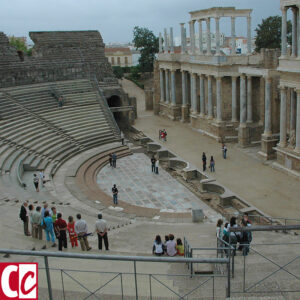


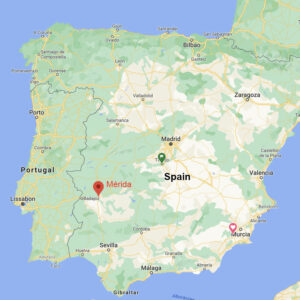
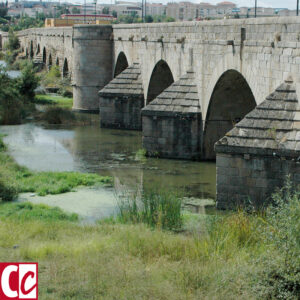

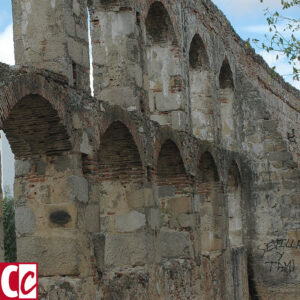



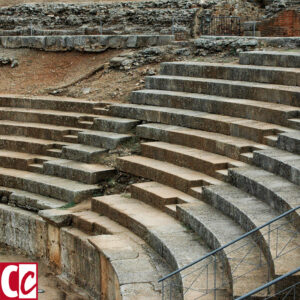


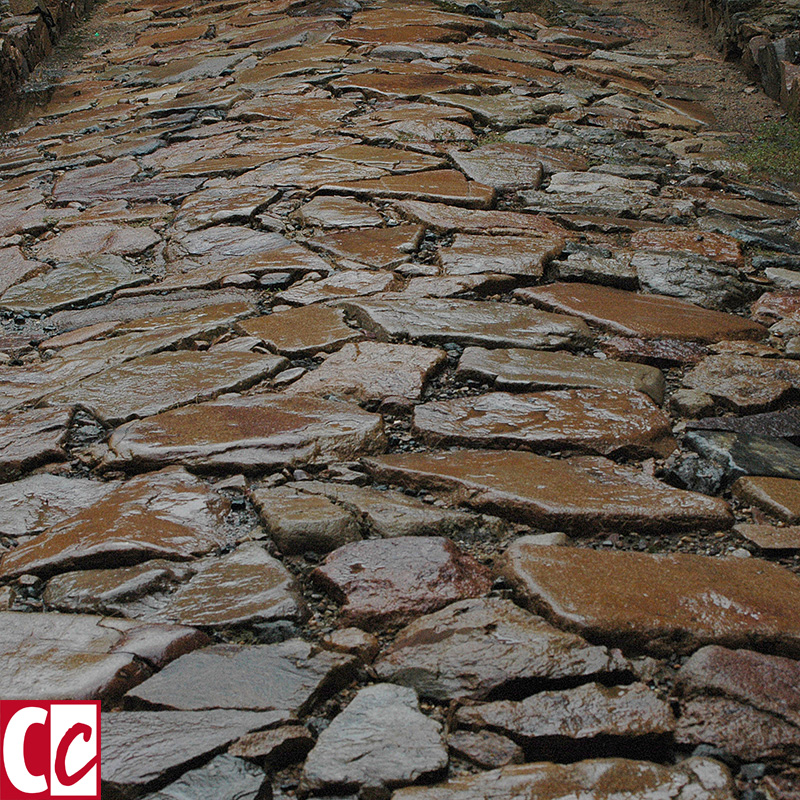
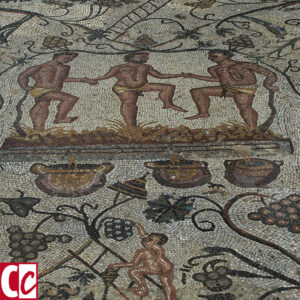
I didn’t realize that these structures were in Spain. They are obviously very well looked after as well.
I have been lucky enough to see a significant amount of Roman architecture while travelling through Turkey, Jordan, Greece, and Italy, however, now you have got me thinking that Merida is a place I’ve got to add to my list.
One of my favorite memories is of going to an opera in an ancient amphitheater in Cyprus, so I would love to experience something similar again. The theater in Mérida, being rated as one of the best in Europe, seems to be the place to go.
Many thanks for sharing your travels with us.
Have a great day
Oh yes, Andrew, performances on location are marvelous. Attending an opera in Mérida is on my bucket list as well. In the Netherlands they have a festival called Oerol with a lot of performances on all kinds of places; the beach, a barn, the dunes. It’s magnificent.
I didn’t know there were Roman remains in Turkey and Jordan. But I should have realized that of course, knowing that the Romans were circling the Mediterranean Sea. As far as Greece is concerns, I can imagine it’s difficult to distinguish which were Roman remains and which were Greek? At times they seem so alike.
No, excavations and old ruins and buildings weren’t always looked after well. But I am glad there has been a shift in thinking. Lucky enough lots of these buildings have been either buried in the soil in time, or integrated in newer buildings. Both events made sure they were kept.
You have a great day too, Andrew, take care.
Hi Hannie,
yet another really cool blog post. Merida looks really impressive. I think it’s pretty impressive what the Romans where able to build, and how well many of those structures lasted. I remember standing in front of the Colosseum in Rome (and in Las Vegas, lol) but also the Porta Nigra in Trier, Germany. Those buildings are 2000 years old… It’s pretty impressive when you think about it. What modern structure is built to last for such a long time? Have you ever been to Trier?
Very cool blog post and great pictures.
Thanks, Hannie.
Chris
Ha ha, Las Vegas has everything, Chris, even a Venetian canal.
Like you, I am not sure many of our modern buildings will last that long. In fact, a lot of buildings that were designed by famous and less famous architects were made with solely the visual aspect in mind. The Arts Academy I was visiting was such a prestige object, and leaked rain water from day 1.
I have only passed Trier, sitting in the back seat of my parents’ car, for our holidays in Italy. But I must make sure to put it on my list for when we are allowed to travel again. A lot of German cities have such beautiful old buildings. Aachen and Köln were not that far from my former house, so we know the buildings over there pretty well.
Hi Hannie,
It still astounds me just how much of the world came under the Roman Empire all those years ago.
The Roman Empire was certainly one that I studied in my very early days of schooling, but alas, I was probably too young to understand or appreciate most of it.
That being said, I’m still amazed to see places here in the UK that we were obviously part-and-parcel of the era.
Funnily enough, just looking at the photos you’ve included of the theatres in Merida, I for one moment actually thought they were taken in Rome itself.
It just goes to show how much of the architecture was shared with various countries.
The Roman Art Musuem and preserved Roman Houses that you’ve mentioned would be of particular interest to me.
I recall going on a school trip at the age of 8 or 9 and we visited a Roman Art Museum in London. I remember being infatuated with mosaic designs.
It sounds like you had a wonderful time, and one thing’s for sure, I wouldn’t have required any I.D. from you to prove you were over 65, Hahaha.
I’m joking, LOL.
Just out of interest, does your son still live in Extremadura?
The entire region looks fantastic, and it’s always nice to have more than one reason to go back.
Partha
At the moment my son lives in the vicinity of Madrid. Back then he lived in the province of Toledo, still about 3 hours driving from Mérida. That’s why we couldn’t visit the town extensively that first time. But it was enough to make us want to go back. You will love it as well, I am sure.
If you love mosaics you should also visit Ravenna in Italy. Or have you done that already? It’s of a later time period (8th century), early Christian, but they are absolutely astounding.
As far as I remember I visited a Roman excavation in the neighborhood of London as well, when I was a teenager. But the Cutty Sark in Greenwich made more of an impression back then, so I am not sure. It is indeed amazing what kind of footprint the Romans have left all over Europe. Even in the Netherlands, that was mainly water and a swamp in those days!
Hi Hannie,
Madrid is a beautiful city, I visited there when I was a kid and I just remember it having beautiful buildings and a relaxed atmosphere. I never knew there was a place called Merida and it was all about ancient roman history. This is something that I would love to see when we are allowed to fly abroad again. This will be a great place to visit to get away from everything that is happening at the moment in the world.
Thank you for sharing such a beautiful place and inspiring me to want to visit there someday.
I will let you know when I eventually do go and visit, and I will give you my review of the place. Which I know will be a great review.
Keep up the amazing work you do Hannie and have a Safe and Happy New Year.
All the best,
Tom
Wow! Merida looks like an amazing place to visit. I love history and I love visiting historical places. I watched the video and it really seems as if you’re stepping back in time. The video also showed a mock gladiator fight, are they holding those for tourists? It must be interesting to see.
I have been in Spain a few times, but I didn’t know that Merida had so much history. Next time I go, Merida is definitely on my list, I am going to see it one day. We’ll see when, hopefully after covid settles down a little.
Yes, Christine, Mérida is amazing. It’s a bit out of the usual touristic areas, that’s probably the reason it’s not very famous. That is of course also a big advantage for those who do visit. It is not awfully crowded.
We neither would have visited the place if it hadn’t been for the friend of our son. That’s so great if you meet a local with an interest in such places.
I am not sure about the enactments of the ancient roman history. We haven’t yet visited one in Mérida. There are a lot of such events in Spain, usually when they have the day off because of the celebration of a Saint’s day.
Talking about Saints. Tom used to say that when you enter Spain on January 1 and travel around it should be possible to only visit shut-off villages and towns because of a Saint’s day. This exclamation was partly out of frustration, because we can’t count the number of days we were in a town and all the shops, banks and other essential businesses were closed-for-celebration. ROFLOL